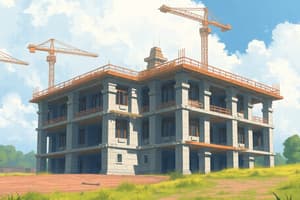Podcast
Questions and Answers
A real estate investor acquires a newly constructed RCC building. For depreciation calculation purposes in the first two years, what percentage of the construction cost can be considered?
A real estate investor acquires a newly constructed RCC building. For depreciation calculation purposes in the first two years, what percentage of the construction cost can be considered?
- 85%
- 75%
- 100% (correct)
- 90%
A 3-year-old permanent building is being assessed for its current value. What depreciation percentage should be applied to the original construction cost?
A 3-year-old permanent building is being assessed for its current value. What depreciation percentage should be applied to the original construction cost?
- 90%
- 100%
- 85% (correct)
- 95%
An individual erects a temporary structure on their land. When calculating depreciation for the first two years, what percentage of the construction cost is typically considered?
An individual erects a temporary structure on their land. When calculating depreciation for the first two years, what percentage of the construction cost is typically considered?
- 85%
- 75%
- 100% (correct)
- 90%
A permanent building is now six years old. What annual depreciation percentage is applied to determine its current depreciated value?
A permanent building is now six years old. What annual depreciation percentage is applied to determine its current depreciated value?
A business utilizes a temporary structure that is now eight years old. What is the annual depreciation percentage applicable for calculating its present value?
A business utilizes a temporary structure that is now eight years old. What is the annual depreciation percentage applicable for calculating its present value?
An established RCC building is undergoing an audit. What is the maximum cumulative depreciation that can be claimed over its entire lifespan?
An established RCC building is undergoing an audit. What is the maximum cumulative depreciation that can be claimed over its entire lifespan?
Flashcards
RCC building depreciation (0-2 yrs)
RCC building depreciation (0-2 yrs)
100% depreciation is considered for RCC buildings up to 2 years old.
RCC building depreciation (2-5 yrs)
RCC building depreciation (2-5 yrs)
85% depreciation is considered for RCC buildings aged between 2 and 5 years.
Semi-permanent building depreciation (0-2 yrs)
Semi-permanent building depreciation (0-2 yrs)
100% depreciation for semi-permanent buildings happens within the first 2 years.
RCC annual depreciation (>5 yrs)
RCC annual depreciation (>5 yrs)
Signup and view all the flashcards
Semi-permanent annual depreciation (>5 yrs)
Semi-permanent annual depreciation (>5 yrs)
Signup and view all the flashcards
Maximum depreciation for RCC buildings?
Maximum depreciation for RCC buildings?
Signup and view all the flashcards
Study Notes
- RCC or permanent buildings up to 2 years old have a depreciation percentage of 100%.
- RCC or permanent buildings aged 2 to 5 years have a depreciation percentage of 85%.
- Semi-permanent or temporary buildings up to 2 years old have a depreciation percentage of 100%.
- After 5 years, RCC or permanent buildings depreciate annually at a rate of 1%.
- After 5 years, semi-permanent or temporary buildings depreciate annually at a rate of 1.5%.
- The maximum depreciation limit for RCC or other permanent buildings is 70%.
- The maximum depreciation limit for semi-permanent or temporary buildings is 85%.
Studying That Suits You
Use AI to generate personalized quizzes and flashcards to suit your learning preferences.




